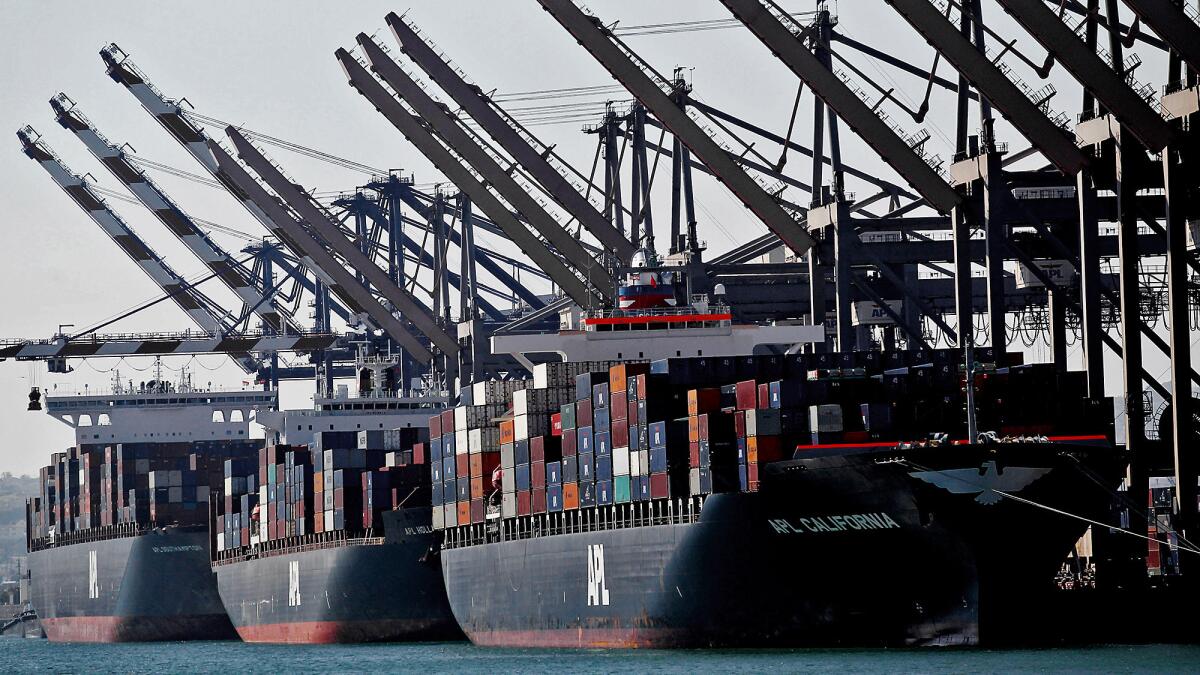Small but powerful union is at center of port dispute

- Share via
The dispute that has snarled West Coast shipping revolves around a rarity in American business — a small but mighty union.
The International Longshore and Warehouse Union represents 20,000 dockworkers, a fraction of the organized ranks of teachers, truck drivers or healthcare workers. But the port workers — who still queue up at hiring halls daily for work and spend years earning full membership — stand guard over a crucial chokepoint in the global economy.
For decades these “lords of the docks” have been paid like blue-collar royalty. Their current contract pays $26 to $41 an hour, with free healthcare for members. Some earn six figures with overtime. Even as a growing chorus of business groups clamor for a resolution to their months-long contract talks with the Pacific Maritime Assn., which represents shipping companies, the union sees little need to back down.
“They have unique skills that aren’t easily replaced,” said Goetz Wolff, who teaches about labor and economics at the UCLA Luskin School of Public Affairs. “They’re not going to roll over and play dead.”
They went back to work Tuesday, after a holiday weekend port shutdown that left dozens of ships parked off the Southern California coast. They also returned to the negotiating table, where U.S. Labor Secretary Thomas Perez is now trying to broker a deal.
The talks have dragged on since May, but tensions have ramped up in recent days, with the shippers group all but closing the ports over the weekend and each side accusing the other of slowing operations. Both parties say they want to avoid repeating the 10-day lockout of 2002, which then-President George W. Bush stepped in to end. They have reportedly agreed on many major elements of a new contract but remain at odds over finer points, including the job of a particular arbitrator who handles disputes on the Los Angeles and Long Beach docks.
The same forces that have pulverized private sector unions in other industries — overseas manufacturing, lower transportation costs, global markets — have strengthened the hand of the ILWU, said economists who study global trade.
“Every day, ship owners have to pay a lot of money for a ship. The cranes are very expensive, and if they’re not being used, that’s wasted money,” said Marc Levinson, an economist and author of “The Box: How the Shipping Container Made the World Smaller and the World Economy Bigger.” “Containerization made the shipping industry very capital-intensive, and that effectively gave power to the union.”
So did two decisions by ILWU’s founder and longtime president, Harry Bridges.
The first was negotiating a single contract covering every port from San Diego to Bellingham, Wash. That prevents shippers from playing one West Coast port against another, as sometimes happens on the East Coast, said Peter Olney, a former organizing director at ILWU.
The other was a 1960 agreement that embraced the arrival of containerization, essentially agreeing to shed thousands of jobs manually hauling crates and bags from ships’ holds in order to save thousands in the higher-tech — and higher-paid — work of operating forklifts and giant cranes.
As container traffic boomed in the decades since, that tough choice paid off, Wolff said.
“It was a brilliant quid pro quo,” he said.
But the industry faces a new round of changes.
Ever-larger ships are dumping more cargo at once on the docks, creating more congestion even when the work is going smoothly. That’s increasing the demand for automation, said Levinson, who noted that ports in Europe and Asia increasingly use robotics to move goods that union longshoremen handle today on the West Coast.
Another threat is the widening of the Panama Canal, scheduled for completion next year. That will enable some larger ships to pass more quickly to the East and Gulf Coast, though experts disagree on how much that could hurt Southern California.
Still, the ILWU shouldn’t overplay its hand, Levinson said.
“The employers and the union both have a common interest in the success of L.A.-Long Beach and in keeping the port as efficient as possible,” he said.
As the dispute drags on, the union’s solidarity could be a key factor.
The ILWU is known as an aggressive union — forged in violent strikes on San Francisco’s Embarcadero in the 1930s, booted from national labor groups in the McCarthy-era 1950s for being “too red,” and willing to shut down the docks several times in recent years in solidarity with smaller unions. That’s what happened in 2012, when clerical workers at the L.A.-Long Beach docks went on strike and clogged the ports for several days.
Today’s workers come up steeped in tales of that sort of militancy, Olney said, and they see how well it pays off in their wages and company-paid health insurance.
“In the port towns, everyone has a friend, a brother, a cousin, a niece who works in this industry and benefits from the power of the union,” he said.
That’s true in Wilmington, where blue ILWU signs can be seen stuck into fences along Harry Bridges Boulevard, past the massive port complex, and in San Pedro, where nearly every restaurant and store on 6th Street downtown sports a sign in its window: “We support the ILWU and They Support Us.”
At the Lighthouse Deli & Cafe a little further down the peninsula toward the ocean, longtime server Lisa Finney said the ILWU generates good jobs that bring good money to the harbor towns. She would know. Her husband is a union foreman on the docks, and the job affords them a nice house and a comfortable life.
“They keep us going,” she said. “There isn’t anyone here who doesn’t support ILWU.”
Many more would like to join.
Membership is typically earned only after years of so-called “casual” work, which involves showing up in the early morning at the cracked parking lot next to a junkyard in Wilmington, where day labor jobs are doled out — if there’s work to go around — at the lower end of the pay scale.
Log enough hours, and eventually you qualify for full membership, with better hours and full benefits. When they open the rolls to new casuals, Olney said, “the lines are thousands of people long.”
It’s good, if sometimes dangerous, work, said Roman Brink, a longshoreman who lives in San Pedro. For him it’s a family business. His grandfather started working the docks in the late 1940s, when they still hauled crates out of ships’ holds with hooks. He’s had uncles, cousins — in all, probably 50 family members — who worked there over the years, and he counts his fellow dockworkers as an extended family too.
“It’s a brotherhood,” Brink said.
And it’s one he hopes his sons will someday join too, the next time hiring opens up.
“We’ve got to bring them in,” he said.
Twitter: @bytimlogan
More to Read
Inside the business of entertainment
The Wide Shot brings you news, analysis and insights on everything from streaming wars to production — and what it all means for the future.
You may occasionally receive promotional content from the Los Angeles Times.












